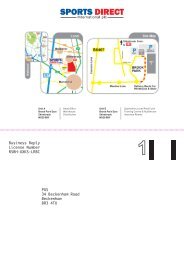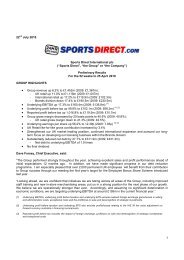Dave Forsey Chief Executive 19 July 2012 - Sports Direct International
Dave Forsey Chief Executive 19 July 2012 - Sports Direct International
Dave Forsey Chief Executive 19 July 2012 - Sports Direct International
Create successful ePaper yourself
Turn your PDF publications into a flip-book with our unique Google optimized e-Paper software.
78 / FINANCIAL STATEMENTS AND NOTES<br />
notes to the Financial Statements<br />
For the 53 weeks ended 29 April <strong>2012</strong><br />
2. Critical accounting estimates and judgements Continued<br />
Useful economic life of intangible assets<br />
For intangible assets which have a finite life, the directors revisit<br />
their estimate of useful economic life at each period end and<br />
revise accordingly. Licences and trade marks typically have a life of<br />
between 10 and 15 years.<br />
Identification and valuation of acquired intangible assets<br />
On acquisition, each material separable intangible asset is identified<br />
and valued by the directors with assistance from a professional third<br />
party. Any such calculation is judgemental in nature as it is based<br />
on a valuation methodology.<br />
Brand valuations are typically valued using the relief from royalty<br />
valuation methodology.<br />
The nature and carrying amounts of these assets are set out in<br />
Note 15.<br />
Provision for obsolete, slow moving or defective inventories<br />
The directors have applied their knowledge and experience of<br />
the sports retail industry in determining the level and rates of<br />
provisioning required in calculating the appropriate inventory<br />
carrying values. The nature and carrying amounts are set out in<br />
Note 18.<br />
Financial position of retirement benefit plans<br />
The net defined benefit pension plan assets or liabilities are<br />
recognised in the Group’s balance sheet. The determination of the<br />
financial position requires assumptions to be made regarding inter<br />
alia future salary increases, mortality, discount rates and inflation.<br />
The key assumptions made in relation to the pension plan are set<br />
out in Note 24.<br />
3. Financial risk management<br />
The Group’s current activities result in the following financial risks<br />
and set out below are management’s responses to those risks<br />
in order to minimise any resulting adverse effects on the Group’s<br />
financial performance.<br />
Foreign exchange risk<br />
The Group is exposed to foreign exchange risk principally via:<br />
a. Transactional exposure from the cost of future purchases of<br />
goods for resale, where those purchases are denominated in a<br />
currency other than the functional currency of the purchasing<br />
company. Transactional exposures that could significantly<br />
impact the income statement are hedged. These exposures<br />
are hedged via forward foreign currency contracts which are<br />
designated as cash flow hedges. The notional and fair value of<br />
these contracts is shown in Note 27.<br />
b. Net investment exposure, from the fair value of net investments<br />
outside the UK. The Group hedges its international<br />
investments via foreign currency transactions and borrowings<br />
in matching currencies.<br />
Provision for dilapidations and onerous lease contracts<br />
The basis of the estimation of the provisioning for dilapidations<br />
and onerous lease contracts is detailed in the provision accounting<br />
policy and Note 26.<br />
Estimates and judgements are continually evaluated and are based<br />
on historical experience, external advice and other factors, including<br />
expectations of future events that are believed to be reasonable<br />
under the circumstances.<br />
Provision for costs relating to regulatory enquiries and other<br />
legal disputes<br />
Provision has been made for legal costs incurred in the current and<br />
previous period relating to ongoing regulatory enquiries and other<br />
legal disputes.<br />
Calculation of Bonus Share Scheme charge<br />
A share-based payment charge is recognised in respect of share<br />
awards based on the <strong>Direct</strong>ors’ best estimate of the number of<br />
shares that will vest. The charge is calculated based on the fair<br />
value on the grant date, which is deemed to be the date on which<br />
the entity and counterparty reached a shared understanding of the<br />
scheme. The key details in respect of the share scheme charges<br />
are set out in Note 21.<br />
c. Loans to non-UK subsidiaries. These are hedged via foreign<br />
currency transactions and borrowings in matching currencies,<br />
which are not formally designated as hedges, as gains and<br />
losses on hedges and hedged loans will naturally offset.<br />
Interest rate risk<br />
The Group has net borrowings, which are principally at floating<br />
interest rates linked to bank base rates or LIBOR. The Group does<br />
not use interest rate financial instruments to hedge its exposure to<br />
interest rate movements. The Group regularly monitors and reacts<br />
accordingly to any exposure to fluctuations in interest rates and the<br />
impact on its monetary assets and liabilities.<br />
Credit risk<br />
The directors have a credit policy in place and the exposure to<br />
credit risk is monitored on an ongoing basis. Credit evaluations are<br />
performed on all customers requiring credit over a certain amount.<br />
The Group does not require collateral in respect of financial assets.



![Our ref: [ ] - Sports Direct International](https://img.yumpu.com/19248141/1/184x260/our-ref-sports-direct-international.jpg?quality=85)





![Our ref: [ ] - Sports Direct International](https://img.yumpu.com/18440214/1/184x260/our-ref-sports-direct-international.jpg?quality=85)

